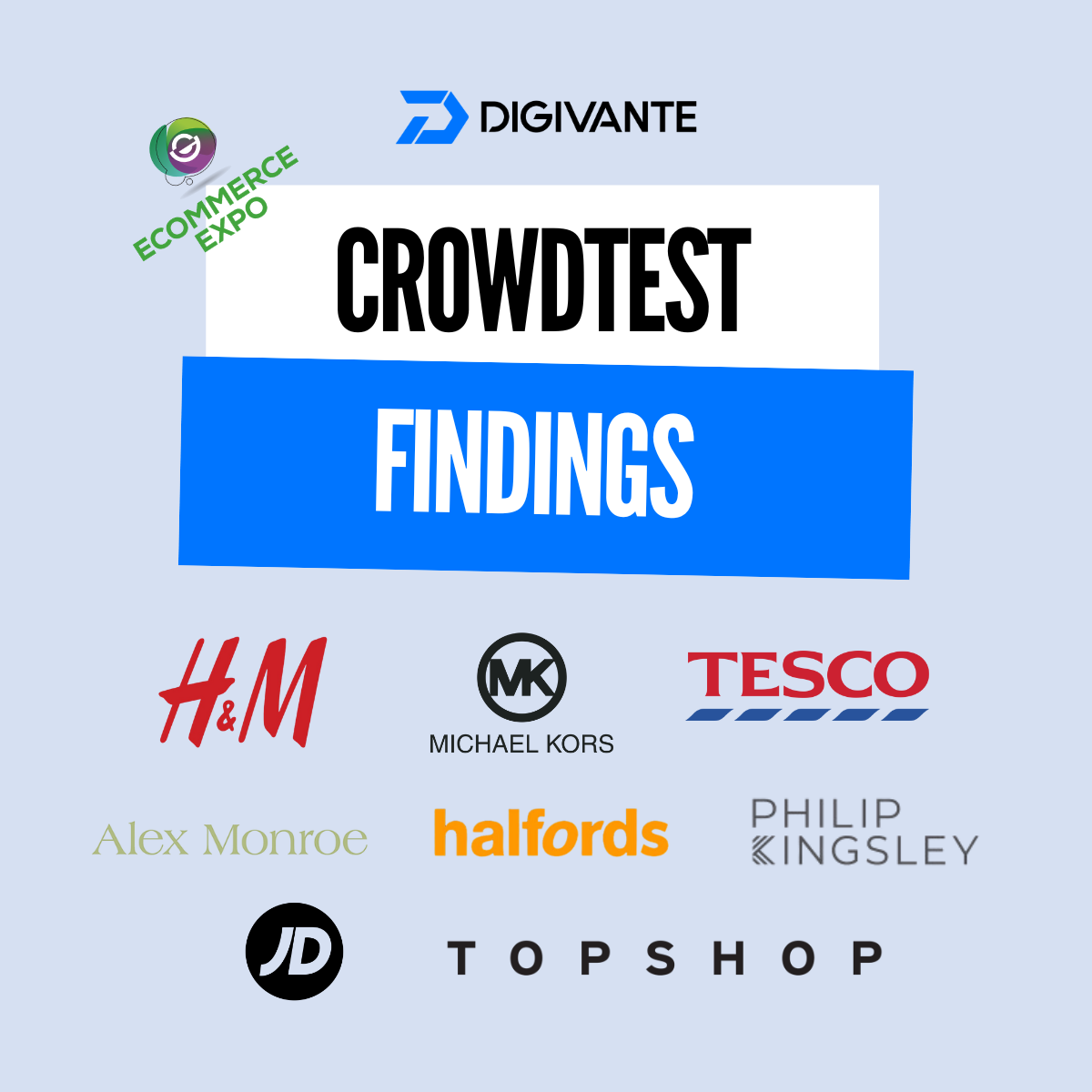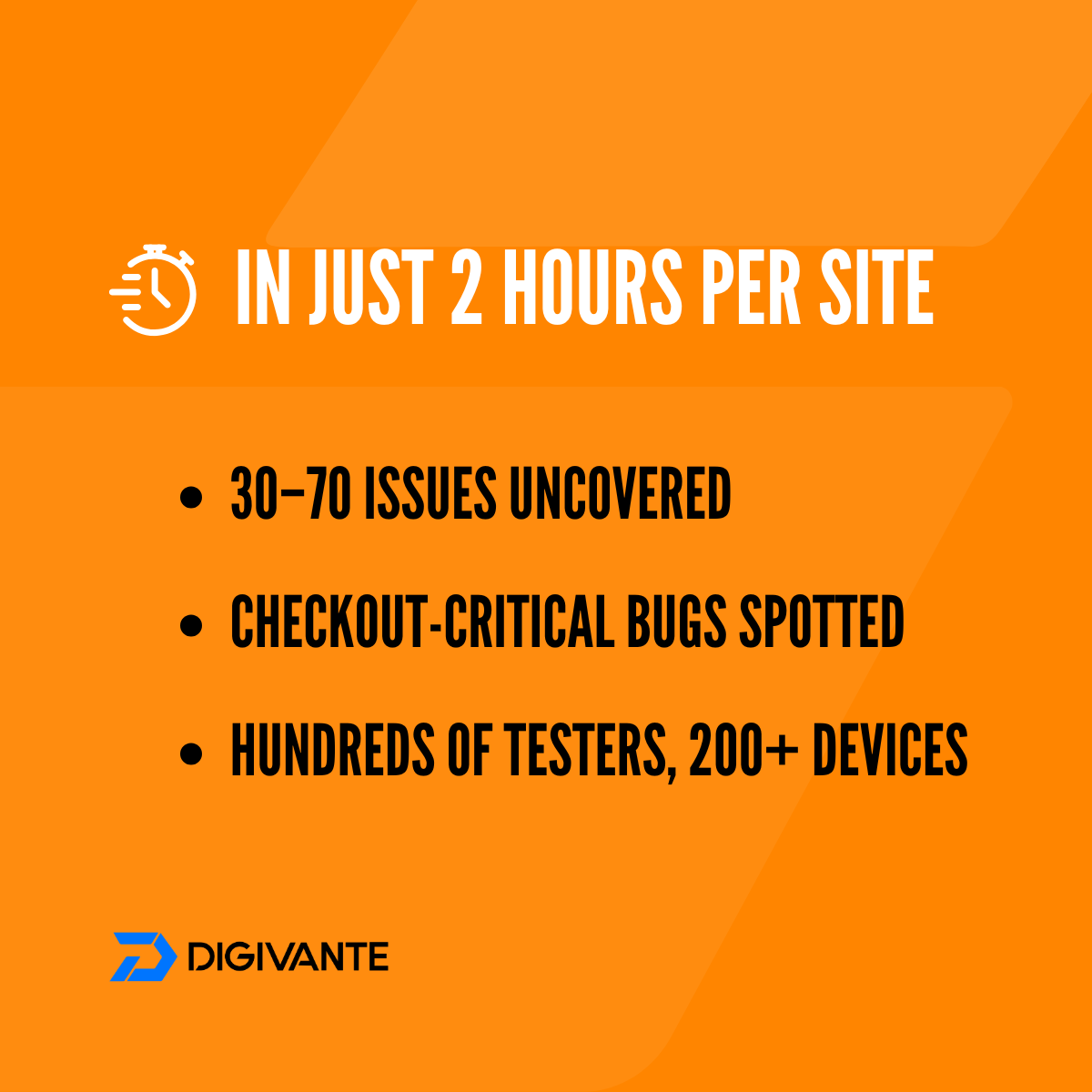What happens when you drop a few hundred testers onto some of the UK's busiest retail websites, while their teams are on stage talking about digital CX?
That was the experiment we ran at eCommerce Expo 2025. The results? As entertaining as the talks themselves, and surprisingly consistent across brands.
Talks at eCommerce Expo that made us sit up
Expo always delivers on big ideas, but this year felt different. The focus shifted from theory to practice, exactly the space Digivante loves.
- Tesco & Serkan Ayan: Shared how UX research drives the evolution of Clubcard and customer journeys. What resonated? The recognition that evidence, not opinion, creates lasting impact.
- Fashion retail leaders (Topshop, JD Sports, Michael Kors): Explored how to keep product discovery seamless when shoppers are bouncing across multiple devices. (Spoiler: our tests showed filters still have a lot to answer for).
- Digital CX panels: Debated scaling personalisation and AI in ecommerce. Ambitious ideas, but our live testing reminded everyone that even the best personalisation strategy fails if your checkout has a glitch…
Our live crowdtests
While the sessions unfolded on stage, we quietly unleashed our crowdtesters on the sites everyone in the room knew.

Each brand got just 2 hours of testing, but the scale was eye-opening:
- 100–200 testers per site
- 200+ devices across mobile and desktop
- 49.6 work weeks of QA effort compressed into hours
Watching results stream in live was electric. Every few minutes, another bug logged. Another friction point flagged. This was no abstract theory about "user journeys", this was real-world evidence, surfacing in real time.
What the data told us
Across all the retailers sites, testers uncovered an average of 50+ issues per each site. Despite different industries, three trends stood out loud and clear:
Filters & Search
The single biggest friction point.
- Filters not applying correctly
- Search not returning expected results
- Difficulty refining products
On one site, the price filter ranges didn't actually match the products displayed, leaving testers scrolling through items far outside their budget.
Another group had to click twice just to activate a sort menu, not exactly the seamless journey retailers aim for.
And in one test, searching for a specific term returned completely irrelevant products, forcing testers to abandon their search altogether.
When product discovery fails, so does conversion.
Product Pages (PDPs & PLPs)
High-frequency issues around:
- Broken buttons
- Missing or unclear information
- Layouts that made comparison harder than it should be
One site's PLP filtering refreshed the page but showed the wrong results. A surefire way to frustrate shoppers.
In another, navigation became clunky after applying filters, with testers struggling to scroll or reset their view.
We also saw product detail pages with content missing altogether, leaving shoppers with no way to evaluate or compare.
If a product page doesn't build confidence, shoppers walk away.
Checkout & Basket
The last hurdle, but sometimes the hardest.
- Baskets not updating properly
- Payment glitches
- Minor UX snags with major consequences
In one case, over 10 testers couldn't complete checkout in under 2 hours because of basket or payment failures. A stark reminder of how fragile conversion can be.
Gift cards that wouldn't apply, discounts that showed misleading totals, and cart counts that lagged or failed to update all combined to create a surprisingly rocky finish line.
Every little bump here risks an abandoned cart.
And across devices…
Many defects were specific to certain devices or browsers. A smooth mobile journey didn't always translate to desktop, and vice versa.
The big picture
- Volume of issues: 30–70 defects per site in just 2 hours.
- Severity: Most were medium or low severity, but a few high-severity bugs showed up in checkout.
- Scale: Hundreds of testers and 200+ device/browser combinations delivered insights that would normally take weeks.

What it means for ecommerce and digital leaders
This wasn't about "catching brands out." It was about proving how much value fresh eyes bring, even to the most experienced teams.
The truth is: every site has friction points. Even those run by the biggest retail names. And they're often in the places that matter most, search, filters, product pages, checkout.
The good news? These issues are solvable. With the right insight, they can be prioritised, fixed, and re-tested quickly. That's where crowdtesting shines: speed, scale, and real-world context.
Final thought
This years eCommerce Expo gave us the perfect stage to showcase what Digivante does best: uncovering insights fast, at scale, and in a way that supports digital teams.
Because if there's one thing our live tests proved, it's this: Weeks of QA can be done in hours, and there are always insights to be found.
Curious what a 2-hour test would uncover on your own site? Book a rapid test with Digivante today.





